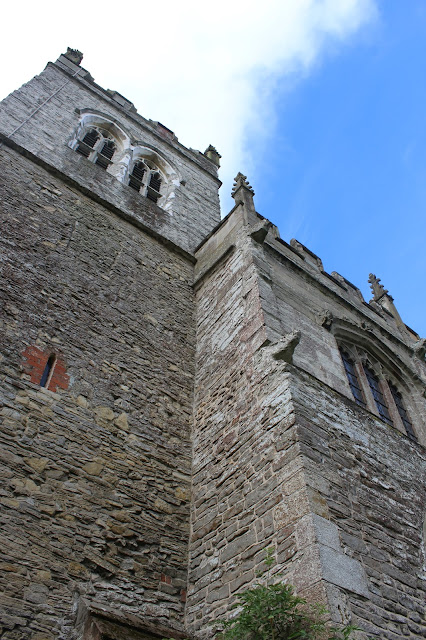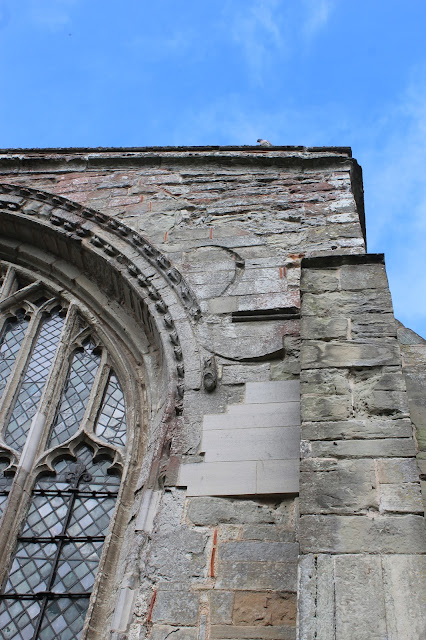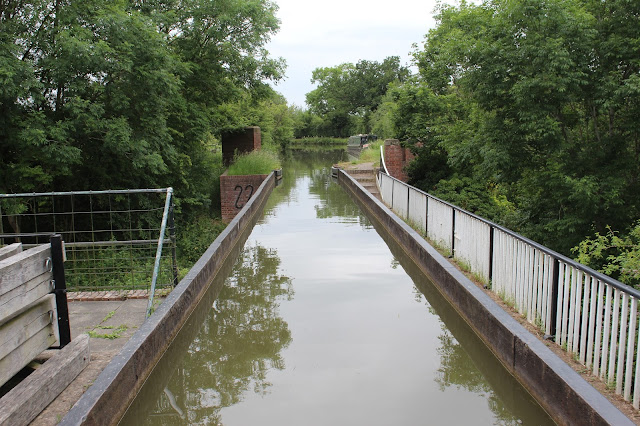Friday, June 30, 2017
Saint Peter's Church, Wootton Wawen
A 13th-century wooden chest in the Lady Chapel, used for storing parish documents.
Another beautiful wooden chest.
Effigy of John Harewell.
Many English churches are filled with needlepoint cushions and kneelers, provided by generations of local women since the 1930s or so, when apparently it became wildly popular. These in the front pews at St Peter's happen to be remarkably lovely, a rather unique single long cushion (as opposed to individual ones, or only thick kneelers) with a variety of floral designs in soft shades on a gently greyish-beige ground. Each of the cushions is different from the rest.
Latch and lock on the 15th-century north doorway.
The expressive faces at the base of the 14th-century octagonal font are said to possibly depict some of the monks of Wooton priory, established in the 1130s!
Late-Saxon or early-Norman door, now blocked.
St Peter's in Wootton Wawen is the oldest church in Warwickshire, founded by the Benedictines in the early 8th century. The base of the tower is Saxon, although the top of the tower, the clerestory, the battlements, and other parts are "new", being 15th-century!
Cemeterying
This map is atop the monument of Bill Allen (1914-1999), obviously a local-history buff, bless him. The photos above and below are the monument itself.
"Percy Pritchard, of Edstone Hall." Apparently Pritchard was the owner of a large Birmingham engineering firm and himself the developer of a fluid flywheel which would come to be used by busses throughout the UK. Pritchard bought the Georgian manor house at Edstone, demolished it, and in 1930 built a new house, designed by architect Francis Yorke, which still retains many of its Art Deco and Arts & Crafts features, including stone fireplaces, stone mullions, and a full-height leaded- and stained-glass heraldic window depicting
former occupants of the site. The house and extensive grounds were for sale in 2010 for a cool £3,000,000.
"They lie here in hope. John Knight of Barrells, gentleman, and his wife
Joan, daughter of Edmund Rawlins, gentleman, which John died 22 August
1681, and the aforementioned Joan died 4 April 1664. In their memory is
this tablet set by William Knight, armiger, their first-born son." An unusually specific monument, to give the mother's birth name, for which we are grateful even though unrelated! Presumably Barrells is Barrells Hall near Henley-in-Arden, by this time having been in the Knight family for some 130 years; it was later extensively rebuilt, though still quite grand to this day. In the 1740s and 50s, Barrells Hall was the home of Henrietta, Lady Luxborough, whose life sounds straight from the pages of a romance novel.
Francis Smith (ca.1516-1606), at various times MP for Truro and Stafford, justice of the peace in Leicestershire, and sheriff of that county and Warwickshire. A very grand monument, indeed. There is apparently some doubt as to his dutiful association with the state religion, though perhaps Smith is not to be blamed as even the State couldn't make up its mind for some years.
John Harewell (1365–1428), the elder of two John Harewells here at St Peter's. MP for Warwickshire, 1414, and like Francis Smith after him, sometime sheriff of Warwickshire and Leicestershire, along with numerous other offices. He was also owner of the manors at Stourton and Shottery. Descendants in at least one line were early settlers of the Virginia colony. The monument is a chest tomb, shaped like a free-standing chest, unlike e.g. a slab in the floor or a wall monument like the Knights' or Francis Smith's above.
It was a bit of a surprise -- but not at all an unpleasant one, mind, in the long run -- to find after our visit that most of the monuments in St Peter's are not yet posted at Findagrave, and so I had the opportunity later to do some genealogy as well as the more touristy things! If only I'd known at the time, we'd have taken more photos ...!
Wootton Wawen Aqueduct
From the footpath below; the road is the A3400.
Heading south.
Heading north, on the return trip.
The approach into the Wootton Wawen basin, the base for Anglo Welsh Boats.
The Wootton Wawen Aqueduct was built in 1813 by the Stratford Canal Company, and is now a Grade II* listed structure. For those interested -- and why wouldn't we be?! -- its description from "British Listed Buildings" is as follows: "Aqueduct. 1813 with later additions and restorations of 1960. By William Whitmore for the Stratford Canal Company. Cast-iron trough with integral towpath with cast-iron railings to north, brick piers and retaining walls in English bond with ashlar copings. Railings have stick balusters and moulded handrail and brackets. All carried on 3 piers, those 2 to east are splayed, that to west restored. South side of aqueduct has an attached oval plate with inscription: `This Aqueduct was erected by The Stratford Canal company in October 1813, Bernard Dewes Esqr Chairman, W James Esqr Dept Chairman, W Whitmore Engineer.' Crosses Stratford Road, A34 [renumbered A3400 in 1991]. The Southern Stratford Canal was constructed between 1793-1816 at a cost of »500,000. 13.5 miles of the canal from Kingswood Junction, Lapworth to Stratford-upon-Avon was leased by the National Trust in 1960 from the British Waterways Board for restoration. The National Trust acquired the freehold c1964. Wootton Wawen Aqueduct is a Scheduled Ancient Monument, County number 132."
Unusually, the three aqueducts on the Stratford Canal -- Yarningale, Wootton Wawen, and Edstone -- all have their towpaths at the level of the canal bottom, instead of at the water level as usual. One of us will have to walk this next time, as the view of the boats at eye-level must be very strange!
Subscribe to:
Comments (Atom)



















































